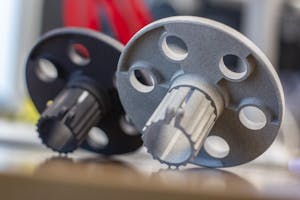HP Multi Jet Fusion (MJF) is a powerful 3D printing technology that produces highly accurate and durable parts at fast speeds, especially compared to other powder bed fusion technologies. MJF technology can be used for end-use, low-volume production, rapid prototyping, or as a bridge process to injection molding.
In this recorded webinar, the 3D printing team at HP teamed up with Greg Paulsen, Xometry's Director of Applications Engineering, and Xometry Europe's Nikolaus Mroncz for an in-depth discussion of their powerful MJF technology and explored its many advantages:
Watch and learn:
- How MJF works and its benefits over other additive manufacturing methods
- Get the most out of processable materials
- Apply design strategies to save time and money on their parts
- Unlock new design possibilities with expert design for manufacturability tips
Hosts:
- Greg Paulsen, Director of Applications Engineering, Xometry
- Nikolaus Mroncz, Additive Manufacturing Sales Engineering, Xometry Europe
- Justin Hopkins, Manager of Application Engineering at HP
- Dustin Kloempken, Application Engineer at HP
The panel finished the session with a live Q&A. The audience questions and panelists' answers can be found below.
Click here to download the PDF presentation of Xometry and HP's Deep Dive into HP’s MJF 3D Printing Technology.
Access material info, design guides, and more on our MJF capabilities page

HP Multi Jet Fusion (MJF) 3D Printing Service
FAQ from the Live Event
Are there available FDA food-safe materials that can be printed using this tech?
HP MJF materials are FDA USP Class VI certified, and vapor smoothing 3D prints can improve the surface and show promising results with Food Contact Tests. However, food safety is an application and requires designs that meet food safety standards. Check out our additive manufacturing guidelines for food products to learn more.
Can MJF PA12 prints be recycled after their intended use?
Unfortunately, most recycling facilities do not take 3D-printed materials due to the uncertainty of their composition, but material manufacturers like BASF and Arkema are working on some recycling programs. 3D printing inherently creates less scrap than other processes like CNC machining, and we have sustainably sourced materials like PA11. On sustainability, Xometry’s GoGreen initiative pays for carbon offsets on their shipments. You can also select for carbon offsets while quoting.
When requesting a quote, how is business confidential information protected?
Xometry values your privacy and security. You always own your data, and Xometry only uses it to estimate, fabricate, and review customer-specific projects. Customer data is not shared outside of Xometry's services, and suppliers are under NDA and other service agreements to protect your IP. We are NIST SP 800-171 compliant and have a robust cybersecurity backend. Learn more here. We are also happy to sign or provide a mutual NDA by contacting support@xometry.com.
What kind of surface treatments are available for HP MJF TPU?
Standard HP MJF TPU will look a matte gray with a slightly graining surface texture. We commonly dye it black or chemical vapor smooth the rubber. Our 3D printing materials finishes gallery is an excellent visual resource. All of these prices are instantly on our Xometry Instant Quoting Engine®.
Would the TPU hold up to high-intensity 365nm UV light? Sun UV? Rain? Saltwater?
We have an excellent BASF Ultrasint TPU01 (TPU 88A) datasheet on our HP MJF Capabilities Page. Start there, and we can also contact BASF to request more information.
Do you see variations within the nested build volume of MJF? For example, do components in the bottom left corner differ dimensionally from components in the upper right corner?
We have a fantastic dimensional report in the “sizes and tolerances” section of our HP MJF. Capabilities Page. Generally, a part has negligible variation based on its placement in the build for this process.
Is there any news on the HP 5420 (white) unit/process?
Xometry is always looking out for new products, materials, and solutions for our customers! If you want to dive deep into the new white material offering, connect with the HP 3D printing team.
What is the build platform size? Or, what is a one-piece maximum part size?
Build area up to 15 x 11 x 15" (14 x 11 x 13" is the recommended usable area). Learn more on our HP MJF Capabilities Page.
What about glass fiber-filled nylon? I am especially interested in glass-filled nylon 6/6.
Fiber-reinforced materials are unavailable in MJF, but we have a spherical glass bead (40%) filled nylon that instantly quotes at Xometry. Learn more on our HP MJF Capabilities Page. To see what’s in the HP pipeline, please connect with the HP 3D printing team.
How does HP MJF compare to Carbon DLS™ (speed, quality, price) for TPU/EPU parts?
HP MJF and Carbon DLS™ are great options for end-use, durable components. MJF tends to allow more design freedom and high-mix into direct digital manufacturing. Although the surface of DLS™ EPU is smoother, chemical vapor smoothing of MJF TPU parts may also bring an acceptable surface quality. Here’s a resource to learn more about manufacturing rubber materials.
What are the main benefits of HP MJF compared to other technology, such as SLS?
Selective Laser Sintering and HP Multi Jet Fusion are great technologies for building durable parts at economical costs with excellent design flexibility. Both powder bed fusion (PBF) platforms have the advantage of not requiring support structures. HP MJF’s advantage is in how its fusion works versus SLS. Where SLS uses a laser to melt the cross-section of a part per layer, MJF uses fusing and detailing agents to deposit over a cross-section quickly, and then an even heat is applied. The heat + fusion agent melts and bonds the neighboring and underlying layers. MJF’s process is speedy, nearly double that of SLS, so you have shortened lead times in production. MJF parts also have more isotropic mechanical properties compared to SLS. Both processes are extraordinary, and at Xometry, we suggest exploring either during your project, but you may find MJF can save costs regularly compared to SLS.
What capabilities do the MJF printers have in overmolding? What is the potential for multimaterial printing?
HP MJF produces a single-material print and cannot achieve overmolding or multi-material printing. Xometry offers PolyJet, capable of full-color prints, digital overmolding, and multi-material 3D printing.
Is a vapor-smoothed MJF finish similar in texture to a media-tumbled SLS?
Chemical vapor smoothing is available for MJF and SLS 3D prints at Xometry. If you consider the standard finish a “sugar cube,” then media tumbling will bring the part(s) to a “satin/eggshell” and vapor smoothing to a “semi-gloss.”
Can you please describe what “Heat Deflection Temperature” is? Why are some temperatures reported and others are not? What is the main takeaway with “Heat Deflection Temperature values?”
Heat deflection temperature, or HDT, is the temperature range where a part deforms under a specified load. It is different than melting (glass transition), which would be the liquefaction temperature of a polymer. HDT is an excellent comparative tool when selecting materials for different environments where they not only get exposed to the heat but are still required to perform at that temperature.
I work as a fashion designer for a company based in Italy, and we make some 3D printed accessories, but we need surface treatment that increases the aesthetical look of 3D printing. Have you some tricks?
Chemical vapor smoothing is an excellent go-to for any surface preparation. Paint-wise, some great paint formulations from Cerakote are specifically for additive manufactured parts. For digital preparation, consider applying textures to your part to mitigate visual layering effects. The HP team can help there!
I work primarily with FDM and SLA printing. Does MJF printing require support? If so, how do you handle them? Mainly if you're working with a large variety of pieces.
HP MJF does not require support structures. To learn more, check out this on-demand webinar about AM Processes that Do Not Require Support Structures.
When you shell a part (for example, to 3 mm), what is more or less the proportion of fusing and detailing agents used?
In MJF, a detailing agent deposits on the outer surface of a part cross-section per layer, so the more surface area, the more detailing agent is required. It stops thermal bleeding and inhibits excess fusion, so it will not affect mechanical properties.
Does part orientation affect mechanical properties in MJF printing?
MJF parts have isotropic properties, meaning their mechanical properties are similar regardless of direction. It is common for parts to be oriented at an angle during building to give an overall consistent matte finish.
What would be the recommended finishing techniques? How do you color the 3D prints?
Because HP MJF parts are naturally gray, and dying black is popular. MJF prints can also be chemically vapor-smoothed for improved cosmetics and performance.
Does MJF PA12 get any UL94 vX yellow card?
HP 3D HR PA12 for MJF has a blue card. Source: UL. It is UL94 HB. Check out this great resource on flame retardant 3D printing plastics available at Xometry.
Polypropylene Co-polymer material (PP- CP variant) can be used in HP MJF?
The HP team can help with this specific material question! You can read more about the HP MJF PP materials Xometry uses on our HP MJF Capabilities Page.
Is there a guide for tolerancing snap-together or print-in-place parts?
Xometry has a downloadable design guide for HP Multi Jet Fusion. You can also check out HP’s MJF handbook for great design tips, fits, and more.
Is it possible to treat a part as thin as a feather with vapor smoothing?
Maybe. MJF is very design-forgiving and can build delicate and fragile details as long as they comply with general design rules. Vapor smoothing is an excellent way to enhance the surface of MJF parts, but there are also design rules. Too thin areas (e.g., less than 1 mm) may fully liquify and look torn or patchy after vapor smoothing. Here’s a guide with eight tips to prevent vapor smoothing defects in your parts.
Does the new metal MJF printer have the same multilayer adhesion properties? Curious as to how that is done technically.
HP has some great online resources for MetalJet. We encourage you to connect with the HP 3D printing team to learn more about their metal 3D printing solution. Xometry also offers alternate metal binder jetting 3D printing you could check out!
What's the short-term future of AI in additive manufacturing?
AI and machine learning continue to play a vital role in Xometry’s business. AI provides instant quoting, strategic sourcing, and mitigating risk in the supply chain. AI-driven design tools like generative design are also incredibly powerful at helping make manufacturable parts without heavy legwork in CAD iteration.
What is the best way to contact you?

